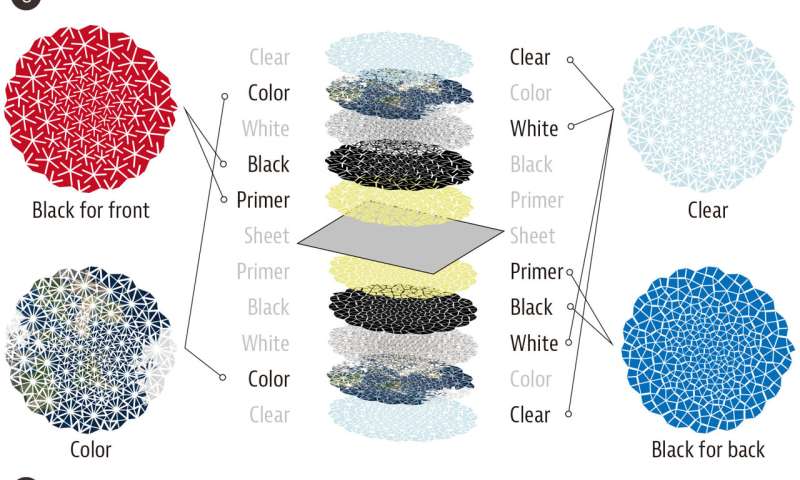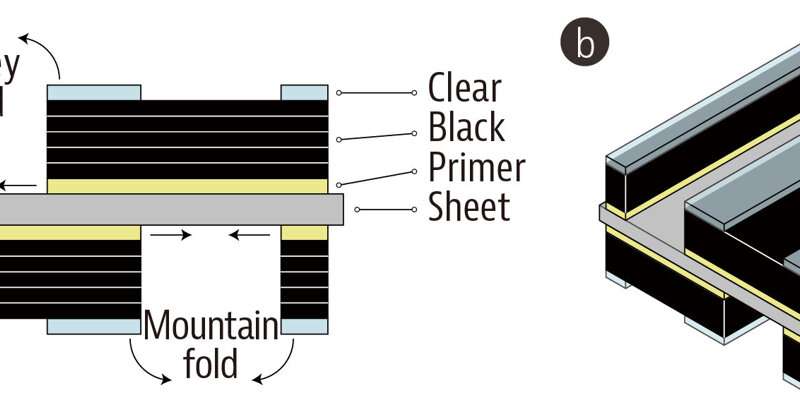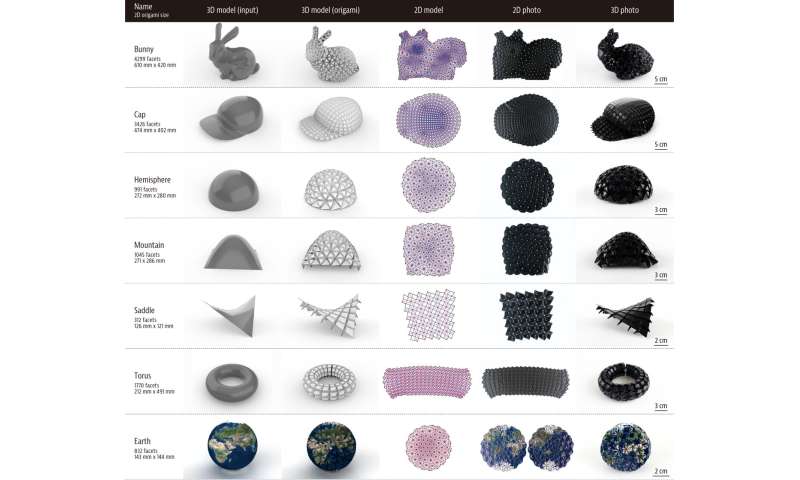This article has been reviewed according to Science X's editorial process and policies. Editors have highlighted the following attributes while ensuring the content's credibility:
fact-checked
trusted source
proofread
Self-folding origami sheets create 3D shapes quickly, cheaply and efficiently

3D printing of complex objects typically takes a long time due to the printing process laying down a large number of 2D layers to build up the object and the process usually wastes a lot of material. Some novel ways to make flat materials self-fold into 3D shapes exist, but they have shortcomings.
For the first time, researchers have combined 2D printing, origami, and chemistry to create a method of rapid 3D object fabrication without creating any waste material. These shapes self-fold in seconds. Their research has been published in ACM Transactions on Graphics.
3D printing has been used for some time to make products. It is now seeing more use in the fabrication of commercial items, including parts for jet engines. But every method of 3D fabrication comes with limitations, such as the long time taken to complete prints or the wastage of vestigial materials in printing.
4D printing is a concept that aims to mitigate these issues using a minimal amount of materials. These materials are selected for having special properties, allowing them to self-fold into complex 3D shapes, under the right conditions. It's called 4D printing, because the process of self-folding makes use of time, which is often said to be the 4th dimension. Ironically, a new method of rapid 4D printing begins in the 2D realm.
"My team and I discovered how to use accessible tools and materials to create self-folding 4D objects," said Project Assistant Professor Koya Narumi from the Department of Electrical Engineering and Information Systems at the University of Tokyo. "Essentially, we're creating flat sheets with origami patterns on them, and these patterns can be complex, taking even a skilled origami artist hours to form. But thanks to our special process, you can pour hot water over these flat sheets and watch as they spring into complex 3D shapes in a matter of seconds."
The technique utilizes a special kind of inkjet printer that prints with UV-reactive materials. Although the machine itself can cost tens of thousands of dollars, they are often found within shared workshops. This printer prints a 2D origami design onto both sides of a plastic sheet that shrinks with heat.
The ink it uses doesn't shrink and can stay flexible when dry. As the base sheet shrinks when heated and the ink resists the shrinking, by leaving gaps between sections of ink on one side or the other, the designer can control which way a certain section of the sheet folds. Hot water is used to apply heat across the flat sheet so that it spontaneously folds into an intricate origami construction.
"Our biggest challenge was refining the options for hardware and materials, which took over a year to narrow it down to the final choices," said Narumi. "But all the trial and error was worth it; compared to previous research around this same basic idea, we've improved the output resolution by 1,200 times, meaning the designs we can create are not just novelties, but can be used for real applications. In the future, we may explore functional materials, such as conductive or magnetic inks, that could allow for machines and other functional devices."
-

Although the printed origami sheets are essentially flat, they combine many layers of different inks atop and below the central heat-shrink sheet material. A primer helps inks stick to the sheet, even when wet. The black ink is what resists the shrinking to allow folds to take place. A white layer provides a blank canvas for a color layer. And a final clear layer protects all of those below. Credit: ©2023 Narumi et al. CC-BY-ND -

In origami, there are two main types of creases used: valley folds and mountain folds. In each case, the paper is folded either inwards or outwards. To make these folds, gaps are left on one side of the heat-shrink sheet to allow for that part of the sheet to fold inwards, like a valley, or outwards, like a mountain, when heat is applied. Credit: ©2023 Narumi et al. CC-BY-ND -

The software the team created is based on an important algorithm in the field of origami. It can decompose a 3D input object and output a 2D pattern. This process would take a human artist time, patience and a lot of trial and error. This algorithm is what first inspired the team to explore the idea of rapid 4D fabrication and is fundamental to the process. Credit: ©2023 Narumi et al. CC-BY-ND
Narumi and team hope this innovation can find use in various fields such as fashion, where material wastage is often high, especially in areas where bespoke designs are sought after.
But given the fact that pre-folded shapes are entirely flat, there's also scope for this to be useful in any situation where there are tight logistical or storage concerns. Printed designs could even be posted, and the recipient could then heat them to turn them into the item they ordered. And there could even be a use in the area of disaster recovery, where certain items, possibly including medical items, are needed but are often difficult to transport, and it becomes a lot easier when the items required are essentially flat.
More information: Koya Narumi et al. Inkjet 4D Print: Self-folding Tessellated Origami Objects by Inkjet UV Printing, ACM Transactions on Graphics (2023). DOI: 10.1145/3592409 , narumi.me/inkjet4dprint



















